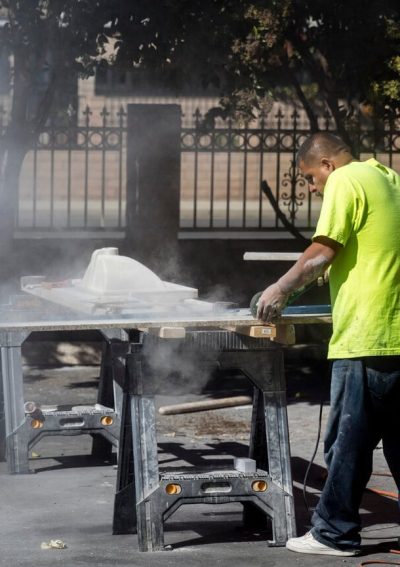Silicosis Lawsuit
Manufacturers of quartz and other stone products are among those facing silicosis lawsuits. Employees exposed to unsafe levels of silica dust may develop silicosis and other damaging illnesses, leading to legal liability for employers who fail to protect their health.

Latest Updates in Silicosis Lawsuits
There currently is no multidistrict litigation established for silicosis lawsuits. Cases are in their early stages and no settlements have been announced.
- November 2023: People diagnosed with silicosis who worked in the quartz and engineered stone industries continue to file lawsuits against manufacturers.
- September 2023: The U.S. Department of Labor announced a new initiative to protect workers from silica exposure.
- July 2023: The American Medical Association released a new study that looked at occupational silica exposure and development of silicosis among 52 workers.
Those diagnosed with silicosis from their exposure to silica dust during employment may receive financial compensation from a silicosis lawsuit. Occupational exposure to silica dust particles from construction materials and stones such as quartz and granite is the leading cause of silicosis.
Global Silicosis Lawsuits
Exposure to silica dust isn’t just a concern in the United States. Countries all over the world are facing rising cases of silicosis, with many of those diagnosed seeking justice from their legal systems.
Lawsuits are being filed against manufacturers that provided unsafe working conditions that led to workers developing this serious lung disease.
-
May 2023:
Construction firm John Holland Group experiences legal challenges as union workers petition the Australian courts for justice in a known safety breach and the illegal action of preventing the Australian Workers' Union from monitoring silica dust levels on job sites.
-
February 2023:
The Spanish business owner of kitchen worktop manufacturer Cosentino admits to covering up the dangers of a top-selling product, leading to the diagnosis of silicosis in 1,900 workers. A plea bargain with the court left him with a six-month suspended prison sentence.
-
February 2023:
The South African Supreme Court of Appeal strikes down an appeal by gold mining companies East Rand Proprietary Mines and DRDGOLD over the high court's decision to certify a class-action suit brought by workers with silicosis.
-
March 2021:
The first settlement of monies from a class-action suit against South African gold producers settled in 2019 reaches seven plaintiffs.
-
July 2019:
A South African high court approves a $332 million (5 billion rand) class-action settlement in favor of mineworkers who developed silicosis from working conditions. Of the companies named in the class-action brought to the high court, 19 reach historic settlements.
Given the impact of the disease and the close link to working conditions, there are several nations looking into restrictions on the use of materials that produce silica dust. Australia leads the way with the most comprehensive changes as it seeks a total ban on engineered stone products.
Why Are People Filing Silicosis Lawsuits?
Silicosis lawsuits are a way for individuals to recover compensation and damages from parties responsible for their exposure to silica dust. While there are a number of symptoms and responses to prolonged inhalation of silica dust, the primary illnesses and complications at the root of many lawsuits include:
- Extensive medical care expenses
- High mortality rate and morbidity once diagnosed with silicosis
- Inability to work, resulting in lost wages
- Increased risk of lung cancer, chronic obstructive pulmonary disorder and kidney disease
- Inflammation and scarring of the lungs, causing fibrosis and silicosis
There is no cure for silicosis. The latency period, which is the time between exposure and first symptoms, ranges from a few years to decades.
Since exposure to silica dust is preventable, individuals required to work in unsafe conditions where inhalation is likely are not responsible for their exposure. Employers have a duty to implement prevention measures or work with safer materials. Liability for the resulting health complications rests with these employers.
Unfortunately, many workers are unaware of the dangers they face in their workplaces, especially if organizations are not forthcoming about the environmental health conditions. There is an increase in the number of marginalized workers receiving a diagnosis of silicosis. Latino men make up a large population of those affected.
Silica Exposure in the Workplace
The most common exposure to crystalline silica comes from quartz, naturally found in several forms of rock or in the Earth’s surface. Whenever cutting, drilling, sanding, grinding, demolishing or mixing materials containing silica, workers can experience exposure to airborne particles. Smaller particles get inhaled deep into the lungs and lodge in the lung tissue.
- Cement and asphalt manufacturing
- Crushing and drilling rock and concrete
- Demolition work
- Masonry and concrete work
- Mining and tunneling
- Sandblasting
The smaller the particles, the greater the risk for silica damage. Cutting and polishing quartz countertops creates an environment where there is a high probability of exposure. While there has long been a movement to eliminate silicosis as a health concern through prevention and awareness, there are still changes that need to occur.
Silica Standards and Regulations
In June 2023, the United States Department of Labor announced a proposal by the Mine Safety and Health Administration to change the federal standards for exposure to respirable crystalline silica to improve protection levels. The changes will lower the accepted exposure limits.
The Occupational Safety and Health Administration is just one of the governing bodies within the United States putting in place safety measures for workers. An acceptable level for respirable crystalline silica is 50 micrograms per cubic meter of air in an eight-hour, time-weighted average, according to OSHA. Actionable levels are 25 micrograms over an eight-hour day.
In addition to monitoring the air quality for workers, personal protective equipment and countermeasures are also necessary. These can include respirators, dust controls, ventilation, water-suppression systems for dust, etc. Medical surveillance is another important element in preventing unnecessary silicosis.
Who Is Eligible to File a Silicosis Lawsuit?
It is important for workers who experienced exposure to silica dust during their employment to reach out to an attorney for guidance. Those who received a silicosis diagnosis within the last five years or who worked around or faced exposure to silica could have a case. A diagnosis of one of the following medical conditions can also play a role:
- Acute or accelerated silicosis
- Fibrosis or other severe breathing problems requiring medical treatment
- Histoplasmosis
- Lung cancer
- Scleroderma
- Systemic lupus erythematosus
- Tuberculosis
The complex nature of litigation and silicosis claims needs experienced legal counsel to navigate. Speak to a lawyer to determine the strength of your legal case and options for a silicosis lawsuit settlement.
How to File
If you received a diagnosis of silicosis and feel your employer is to blame, talk to a lawyer. An attorney can determine your eligibility for a claim, select the defendants and build evidence to support your claim.
Silicosis lawsuit settlements can provide compensation and damages for lost wages, medical expenses and more. If you lost a loved one to silicosis, an attorney can help with a wrongful death lawsuit.
19 Cited Research Articles
Consumernotice.org adheres to the highest ethical standards for content production and references only credible sources of information, including government reports, interviews with experts, highly regarded nonprofit organizations, peer-reviewed journals, court records and academic organizations. You can learn more about our dedication to relevance, accuracy and transparency by reading our editorial policy.
- U.S. Department of Labor. (2023, September 25). Department of labor announces enforcement, compliance initiative to protect workers from silica exposure in engineered stone fabrication, installation. Retrieved from https://www.dol.gov/newsroom/releases/osha/osha20230925-1
- León-Jiménez, A. (2023, August). New Etiological Agents of Silicosis. Retrieved from https://www.sciencedirect.com/science/article/pii/S0300289623000996
- Bendix, A. (2023, July 25). Quartz Countertops Linked to Deadly Lung Disease in Workers Who Fabricate the Material. Retrieved from https://www.nbcnews.com/health/health-news/quartz-countertops-deadly-lung-disease-workers-rcna95959
- Fazio, J.C. et al. (2023, July 24). Silicosis Among Immigrant Engineered Stone (Quartz) Countertop Fabrication Workers in California. Retrieved from https://jamanetwork.com/journals/jamainternalmedicine/article-abstract/2807615
- Jama Network. (2023, July 24). Silicosis Among Immigrant Engineered Stone (Quartz) Countertop Fabrication Workers in California. Retrieved from https://jamanetwork.com/journals/jamainternalmedicine/article-abstract/2807615
- Federal Register. (2023, July 13). Lowering Miners’ Exposure to Respirable Crystalline Silica and Improving Respiratory Protection. Retrieved from https://www.federalregister.gov/documents/2023/07/13/2023-14199/lowering-miners-exposure-to-respirable-crystalline-silica-and-improving-respiratory-protection
- Benincasa, R. (2023, July 4). Coal Miners Would Be Protected From Black Lung Disease Under Proposed Silica Rule. Retrieved from https://www.npr.org/2023/07/04/1185524447/coal-miners-would-be-protected-from-black-lung-disease-under-proposed-silica-rul
- U.S. Department of Labor. (2023, June 30). US Department of Labor Announces Proposed Rule to Reduce Silica Dust Exposure, Better Protect Miners’ Health. Retrieved from https://www.dol.gov/newsroom/releases/MSHA/MSHA20230630
- Bolza, M. (2023, May 22). Silicosis Fears Prompt Union to Sue John Holland. Retrieved from https://www.9news.com.au/national/silicosis-fears-prompt-acu-to-sue-john-holland-health-court-news/8e32157a-9a18-46af-aab9-78833e424d9b
- Karp, P. (2023, February 28). Australia Moves to Fast-Track Ban on Silica Stone Benchtops That Cause Fatal Lung Disease. Retrieved from https://www.theguardian.com/australia-news/2023/feb/28/australia-moves-to-ban-silica-engineered-stone-benchtops-silicosis-fatal-lung-disease
- Reuters. (2023, February 7). Owner of Spain's Cosentino Admits Negligence Over Silicosis in Workers – Documents. Retrieved from https://www.reuters.com/business/owner-spains-cosentino-admits-concealing-cause-silicosis-1900-workers-2023-02-07/
- Mabuza, E. (2023, February 7). Two Mining Companies Fail in Bid to Appeal Against Silicosis Class Action Certification. Retrieved from https://www.timeslive.co.za/news/south-africa/2023-02-07-two-mining-companies-fail-in-bid-to-appeal-against-silicosis-class-action-certification/
- Nowak-Pasternak, J., Lipińska-Ojrzanowska, A. & Świątkowska, B. (2022, October 22). Silicosis After Short-Term Exposure. Retrieved from https://academic.oup.com/occmed/article-abstract/73/1/33/6769935?redirectedFrom=fulltext&login=false
- Yin, H. et al. (2022). The Emerging Role of Epigenetic Regulation in the Progression of Silicosis. Retrieved from https://clinicalepigeneticsjournal.biomedcentral.com/articles/10.1186/s13148-022-01391-8
- Reuters Staff. (2021, March 2). First Claimants Paid in South African Silicosis Settlement. Retrieved from https://www.reuters.com/article/uk-safrica-mining-silicosis-idUSKCN2AU1FX
- State of California DIR. (2019, April 16). Respirable Crystalline Silica Standards. Retrieved from https://www.dir.ca.gov/dosh/respiratory-silica-FAQ.html
- Case Text. (2008, November 14). In re Silica Products Liability Litigation. Retrieved from https://casetext.com/case/in-re-silica-products-liability-litigation
- United Harris Martin. (2005, July 1). Silica MDL Judge Issues Order Remanding Claims for Lack of Jurisdiction. Retrieved from https://www.harrismartin.com/publications/8/occupational-exposure-litigation/articles/5372/silica-mdl-judge-issues-order-remanding-claims-for-lack-of-jurisdiction/
- U.S. District Court, Southern District of Texas. (n.d.). Order No. 29: Addressing Subject-Matter Jurisdiction, Expert Testimony and Sanctions. Retrieved from https://www.txs.uscourts.gov/sites/txs/files/203md1553-1902.pdf
Calling this number connects you with a Consumer Notice, LLC representative. We will direct you to one of our trusted legal partners for a free case review.
Consumer Notice, LLC's trusted legal partners support the organization's mission to keep people safe from dangerous drugs and medical devices. For more information, visit our partners page.
855-842-1699

